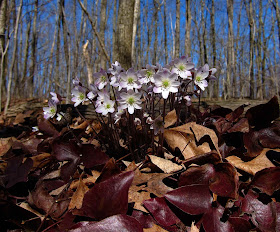Today was the kind of day we wait for all year, when the light and the warmth and the birdsong and burgeoning flora convince us that winter is over at last. We were not going to waste it, either, Sue and I, so we went for a walk together in Skidmore Woods, choosing trails that took us along a limestone ridge, the dappled sunlight making it all the way down to us through the still leafless canopy.
At first sight, we didn't see much that was blooming, but soon our eyes began to detect the numerous clumps of Hepatica just opening their pretty blooms to the warmth of the morning sun. Sue and I both agreed that this was one of the biggest clumps of Hepaticas we had ever seen.
I didn't expect to find Leatherwood today, since deer had decimated the shrubs over the winter. But lo! We found out that the deer had missed quite a few. I was so delighted to once again find their yellow-anthered trumpets dangling down from their just-opened furry buds.
The staminate culms of Plantain-leaved Sedge have not yet sprouted their wild-haired yellow anthers, but the feathery white pistillate flowers along the stems are already open, just waiting to receive that pollen.
I made sure to show Sue the patch of English Violets now blooming profusely along one of the carriage lanes that run through the woods, probably planted there by Victorian ladies, who might have enjoyed little nosegays of these delightfully fragrant flowers.
I puzzled over these violets for years, noting their pristine white
petals with no dark veining at all, as well as the spur that was always
colored deep purple. Thanks to help from some botanist friends, I finally learned the name of this introduced species, Viola odorata, an intensely fragrant species that is usually deep purple. Although this patch is the white (alba) variety, sometimes I see quite a bit of purple tingeing to the petals, as in this little clump. There is a patch of the purple variety on the other side of the Skidmore campus, and those are equally fragrant.
If we have a few more of these warm sunny days, the forest floor will soon be exploding with bloom. Already, we found some tiny babies, just waiting to open their buds. The acorn cap lying next to it reveals how very small this baby Bloodroot is.
It won't be long before Early Meadow Rue will be opening those tightly packed buds. This species bears staminate and pistillate flowers on separate plants, but I could not yet tell if this was a boy or a girl. When in full bloom, the difference is obvious.
No flower buds yet on these crinkly baby Wood Betony sprouts, each one of which could sit on a dime, they are so small. What they lack in size, though, they make up for with color and texture.
After Sue had to leave to get ready for work, I decided the day was much too lovely to move indoors, and I drove a couple of miles away to the Bog Meadow Nature Trail just east of Saratoga. I was hoping to find the Spring Beauty that flourishes there, but I saw no sign of it yet. The Speckled Alders, however, were in full bloom, or at least some of their catkins were. This cluster shows two ripened staminate catkins dangling down beside a not-yet-ripened one. The fuzzy red puffs on the branch above are the female, pistillate flowers.
One section of the Bog Meadow trail is a virtual forest of Field Horsetail, and I saw today that its fertile stems had started to emerge. After ripening, these stems will spill their spores from that cone-like structure on top (called a strobilus) and the entire structure will disappear. The leafy green sterile stems, which grow separately from underground roots, can photosynthesize their own food and will persist through the summer and fall.
I had never before seen a fertile stem just emerging from the ground. A little bug was already finding its strobilus irresistible.











Such beautiful observations, thanks for sharing.
ReplyDeleteAnd thank YOU, Cranky, for stopping by to leave your kind comment.
ReplyDelete